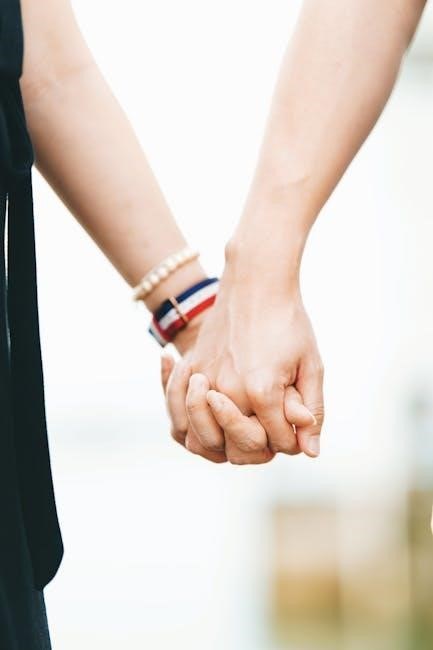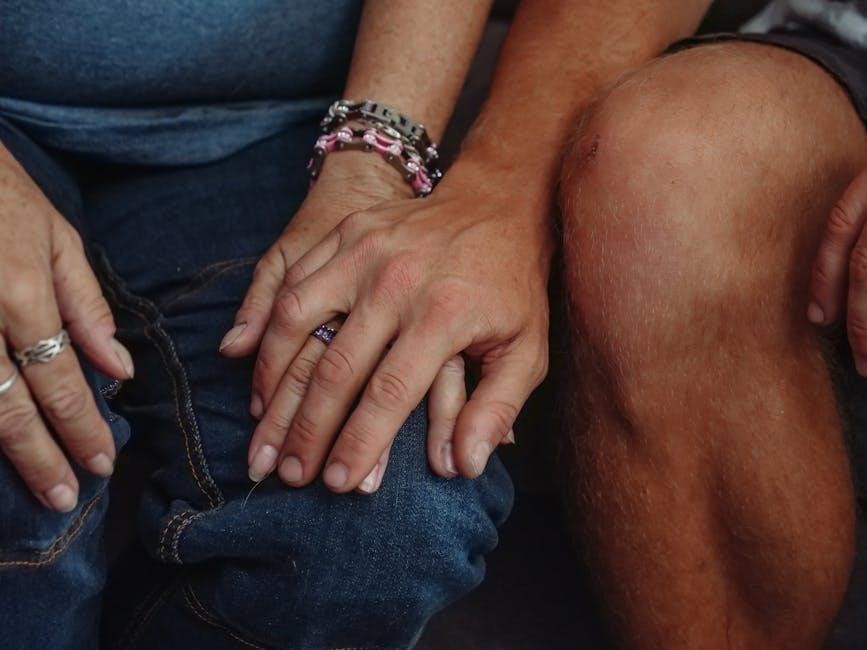printable friendship bracelet instructions pdf
Friendship bracelets are a meaningful way to celebrate bonds, crafted with embroidery floss and simple knots. They symbolize friendship and are easy to create with printable guides.
What Are Friendship Bracelets?
Friendship bracelets are handmade accessories, typically wrist-worn, crafted using embroidery floss or similar cords. They are created by tying knots in intricate patterns, symbolizing friendship and personal connection. Traditionally, these bracelets are made from embroidery floss, which is affordable and available in numerous colors. The process involves tying knots to form various designs, such as stripes or chevrons. These bracelets often carry cultural significance, representing bonds between individuals. They can be customized with beads or other embellishments, making each piece unique. Friendship bracelets are a popular DIY project, often exchanged as gifts, and have become a timeless symbol of friendship and creativity.
History and Cultural Significance
Friendship bracelets have origins tracing back to Central and South America, where they were crafted as symbols of friendship and unity. These handmade wristbands gained popularity in the 1960s and 1970s, becoming a cultural phenomenon worldwide. Traditionally, they are made from embroidery floss or similar cords, knotted into intricate patterns. The act of creating and exchanging these bracelets symbolizes trust, bond, and enduring friendship. Over time, they have evolved into a global craft, with diverse designs and materials, yet their core meaning remains unchanged. Today, they are cherished as tokens of connection and personal expression.
Why Use Printable Instructions?
Printable instructions offer a clear, step-by-step guide for crafting friendship bracelets, making the process accessible to all skill levels. They provide visual patterns, knotting techniques, and material lists, ensuring accuracy and ease. With a downloadable PDF, you can follow along without screen time, making the creative process more enjoyable. These guides are ideal for beginners, as they break down complex patterns into manageable steps. Additionally, printable instructions allow for customization, enabling you to explore various designs and materials. They serve as a handy reference, helping you create meaningful bracelets with precision and confidence, whether for personal use or as heartfelt gifts.

Materials and Tools Needed
To create friendship bracelets, you’ll need embroidery floss, scissors, and tape. Optional materials include beads, a clipboard, and alternative cords like hemp or satin for customization.
Embroidery Floss and Alternative Cords
Embroidery floss is the traditional choice for friendship bracelets due to its affordability, vibrant colors, and ease of use. It comes in a wide variety of shades, making customization simple. For a unique look, you can experiment with alternative cords like colored hemp, satin cord, or cotton cord. These options offer different textures and can add a personal touch to your bracelet. When selecting materials, consider durability and how they complement your design. Using multiple colors or cord types allows for endless creativity and versatility in your friendship bracelet creations.
Basic Tools: Scissors, Tape, and Beads
The essential tools for making friendship bracelets include scissors for cutting floss, tape to secure strands, and beads for embellishments. Sharp scissors are crucial for clean cuts, while tape helps keep strands in place. Beads add a personal touch and can be threaded onto the floss easily. These tools are fundamental for both beginners and experienced crafters. Ensure your scissors are sharp to avoid fraying the floss, and use clear tape for visibility. Beads can be placed strategically to enhance the design, making your bracelet truly unique. Proper use of these tools ensures a polished and professional finish.
Optional Materials for Customization
Enhance your friendship bracelets with optional materials like beads, sequins, or charms for added flair. Beads can be threaded onto strands and knotted in place, creating decorative accents. Sequins or small charms add sparkle and personality. These elements allow for greater customization, making each bracelet unique. Experiment with different textures and colors to match your style. Additional materials can be sourced from craft stores or online. Incorporating these details lets you express creativity and add a personal touch to your bracelet, making it a one-of-a-kind gift or accessory. This step is perfect for those who enjoy experimenting with designs.
Getting Started with the Basics
Begin by tying an initial knot 1-1.5 inches from the top. Use embroidery floss, scissors, and tape to secure strands. Follow the pattern step-by-step carefully.
Tying the Initial Knot
Start by tying a secure double knot at the top of your strands, about 1-1.5 inches from the end. This knot serves as the foundation for your bracelet. Ensure it’s snug to prevent unraveling. Use a simple overhand knot and repeat it once to create a double knot. This step is crucial for maintaining the bracelet’s structure. Properly securing the initial knot ensures your design stays intact as you progress. For a neat finish, trim excess thread close to the knot using sharp scissors. This clean start sets the stage for a professional-looking bracelet.
Setting Up the Bracelet Pattern
Begin by arranging the embroidery floss strands in your desired color sequence. Separate the strands into two equal sets, folding them at the midpoint to create a loop. This setup is ideal for patterns like chevrons or stripes. Secure the strands by taping them to a flat surface, ensuring even alignment. For intricate designs, use a pattern template or wheel to organize the threads. Once arranged, proceed to knotting, keeping the strands taut to maintain consistency. This step ensures your bracelet pattern aligns correctly and evenly, creating a professional finish.
Understanding the Knotting Technique

The knotting technique is the foundation of friendship bracelets. Begin by creating a snug knot with the embroidery floss strands. To do this, loop one strand over the other, tuck the tail under, and pull it up to form a secure knot. Repeat this process, alternating strands to build the pattern. Use forward and backward knots to create texture and design. Keep the strands taut to ensure evenness and avoid looseness. Regularly trim excess thread to maintain a neat workspace. With consistent pressure and attention to detail, you’ll master the technique, enabling you to craft intricate and personalized designs effortlessly.

Basic Knots and Stitches
Mastering forward and backward knots is essential for creating intricate patterns. These knots form the foundation of friendship bracelet designs, allowing you to craft various styles with precision and ease.
Forward Knot
The forward knot is a fundamental technique in friendship bracelet making. It involves crossing one strand over another and securing it with a loop. This knot creates a clean, neat pattern when repeated. To tie a forward knot, take the left strand and pass it over the right, forming a loop. Pull the strand gently to tighten the knot. Practice this step to ensure even tension and a consistent appearance. Printable guides often illustrate this knot with clear visuals, making it easy to follow for beginners. Mastering the forward knot is the first step toward creating more complex designs.

Backward Knot
The backward knot is the reverse of the forward knot, creating a mirror image effect. It is essential for forming symmetric patterns in friendship bracelets. To tie a backward knot, cross the right strand over the left, loop it under, and pull tight. This technique allows for intricate designs when combined with forward knots. Printable guides often provide step-by-step visuals to help master this knot. Consistent tension is key to maintaining a balanced bracelet. The backward knot adds versatility to your designs, enabling you to explore various patterns and styles with ease. Practice this knot to enhance your bracelet-making skills.
Combining Knots for Patterns
Combining forward and backward knots creates a variety of patterns for friendship bracelets. Alternating these knots allows you to design intricate sequences, such as chevron or striped motifs. Start by tying a forward knot, then switch to a backward knot to reverse the pattern. This technique adds depth and visual interest to your bracelet. Printable guides often include diagrams to illustrate how to alternate knots effectively. By mastering this method, you can experiment with complex designs, ensuring each strand aligns perfectly. Consistent tension and careful planning are key to achieving professional-looking results. This approach makes pattern creation intuitive and rewarding for crafters of all levels.

Popular Friendship Bracelet Patterns

Combining forward and backward knots creates intricate designs for friendship bracelets. Alternating these knots allows you to craft chevron or striped patterns. Use printable guides for clear visuals on how to alternate knots effectively. Start with a forward knot, then switch to a backward knot to reverse the pattern, adding depth and visual interest. Maintain consistent tension and carefully plan your sequence to ensure strands align perfectly. This technique is ideal for creating complex yet professional-looking designs, making pattern creation intuitive and rewarding for crafters of all skill levels.
Striped Patterns
Striped patterns are a classic and easy choice for friendship bracelets. They involve alternating colors in a simple sequence, creating a clean and timeless design. To create a striped pattern, cut two or more strands of embroidery floss in your desired colors. Tie an initial knot at the top, then begin knotting the strands in an alternating color sequence. Carry the outermost strand across to create the next stripe, repeating the process until the bracelet reaches your desired length. Use a printable guide to help visualize the pattern and ensure even spacing. Striped bracelets are perfect for beginners and can be customized with as few or as many colors as you like. Their simplicity makes them versatile and quick to complete, while still offering room for personalization.
Chevron Patterns
Chevron patterns add a stylish, asymmetrical touch to friendship bracelets. To create this design, divide your strands into two sets of colors and alternate knotting directions. Start by tying an initial knot and setting up your strands. For a chevron, you’ll alternate between forward and backward knots, creating a zigzag effect. Use a printable guide to map out your color sequence and ensure symmetry. Mix and match colors to create vibrant, unique chevrons. This pattern is ideal for those who want a modern look while still enjoying the simplicity of classic knotting techniques. Experiment with different color combinations to make each bracelet truly one-of-a-kind.
Diagonal Stripe Patterns
Diagonal stripe patterns are a popular choice for friendship bracelets, offering a sleek and modern design. To create this look, start by tying an initial knot and arranging your strands. Use a printable guide to help visualize the pattern. Begin by knotting the first strand, then carry it diagonally across the other strands, switching colors as desired. This technique creates a dynamic, slanted stripe effect. By following the guide, you can achieve uniformity and precision. Diagonal stripes are versatile and can be customized with various colors, making each bracelet unique and personal. They’re perfect for those who enjoy experimenting with different visual styles while maintaining simplicity in their design.

Advanced Techniques and Customization
Elevate your friendship bracelets with advanced techniques like intricate knotting, bead incorporation, and color blending. Printable guides offer detailed steps for creating personalized, unique designs effortlessly.
Adding Beads and Embellishments
Beads and embellishments add a personal touch to friendship bracelets. Choose beads that match your style, such as seed beads or charm beads, and thread them onto your strands. Secure beads by tying knots above and below them. For a more intricate look, experiment with sequins or small pendants. Printable guides often include specific patterns and spacing tips to ensure your beads are evenly distributed. This technique allows for endless customization, making each bracelet truly unique and meaningful for the recipient. With practice, you can master this method and create stunning, beaded designs.
Using Different Colors and Materials
Experimenting with colors and materials adds uniqueness to friendship bracelets. Embroidery floss is traditional, but you can also use hemp, satin cord, or cotton thread for varying textures. Choose colors that reflect personal styles or match outfits. Mixing colors creates vibrant patterns, while metallic or glitter threads add a modern touch. Printable guides often suggest color combinations and material pairings for inspiration. This flexibility allows you to tailor each bracelet to the wearer’s preferences, making it a thoughtful and personalized gift. With endless options, you can create designs that stand out and tell a story.
Creating Asymmetrical Designs
Asymmetrical designs add a modern twist to traditional friendship bracelets. By mixing colors and patterns unevenly, you can create unique, eye-catching pieces. Divide strands into mismatched sets or alternate knotting directions for an off-balance look. Experiment with uneven chevrons or diagonal stripes to enhance the asymmetry. Adding beads or embellishments on one side can also achieve this effect. Printable guides often include tips for balancing asymmetrical elements while maintaining a cohesive design. This technique allows for endless creativity, making each bracelet a one-of-a-kind accessory that reflects individual style and personality.
Troubleshooting Common Mistakes
Even knots, incorrect strand counts, or overly tight/loose knots can ruin a bracelet. Adjust knots gently, count strands regularly, and tighten as needed for a polished finish.
Fixing Uneven Knots
Uneven knots can easily ruin the appearance of your friendship bracelet. To fix them, gently pull on the strands to tighten or loosen as needed. Use a tape or pin to hold the strands in place while adjusting. If a knot is too tight, carefully trim the excess thread with scissors. For loose knots, re-tie them following the pattern instructions. Regularly inspect your knots as you go to ensure evenness. This step is crucial for maintaining the bracelet’s balance and visual appeal.
Adjusting Bracelet Length
Ensuring the perfect fit is crucial for a comfortable bracelet. To adjust the length, measure your wrist and compare it to the bracelet’s current size. If it’s too long, tie a smaller initial knot closer to the top. For a shorter bracelet, trim excess thread after securing the final knot. Use a tape measure to gauge the desired length accurately. Avoid over-tightening, as this can make the bracelet uncomfortable. Once adjusted, secure the ends firmly and trim any leftover thread. This step ensures the bracelet fits perfectly and stays in place without being too tight or too loose.
Repairing Broken Strands
If a strand breaks during your project, don’t discard your work. Identify the broken strand and secure the other threads with clear tape to prevent further tangling. Thread a needle with a matching embroidery floss color and tie a small knot at the end. Weave the needle through the bracelet, following the existing pattern, and tie another knot to anchor the repair. Trim excess thread and blend the repair seamlessly into the design. Regularly inspecting your work and handling strands gently can help prevent breaks. This step ensures your bracelet remains intact and professional-looking despite minor setbacks.
Finishing Touches
Secure your bracelet by tying a tight knot near the end and trimming excess thread. For a polished look, add a small bead or tassel before finalizing.

Securing the Bracelet
To finish your friendship bracelet, tie a secure knot at the end of the strands, leaving a small loop for the clasp or tassel. Trim any excess thread with sharp scissors. For added stability, apply a dab of clear adhesive to the knot. Optional beads or charms can be attached before finalizing. Ensure the bracelet is snug but comfortable, adjusting the length if needed. Double-check the knots to prevent unraveling. This step ensures your bracelet stays intact and looks professional, ready to be gifted or worn with pride.
Adding a Clasp or Tassel
Add a personal touch by attaching a clasp or tassel to your bracelet. For a clasp, thread the end of the bracelet through the loop, tie a small knot, and trim excess thread. Tassels can be added by tying a bead or charm at the end of the strands. This enhances the bracelet’s appearance and functionality, making it easier to wear and ensuring it stays securely fastened. These finishing details elevate your handmade piece, giving it a polished look while maintaining the sentimental value of a friendship bracelet.
Final Inspection and Adjustments
Before completing your friendship bracelet, inspect it for any loose knots or uneven strands. Gently pull on each strand to ensure the knots are secure and the pattern is consistent. Trim any excess thread close to the knot for a clean finish. If needed, adjust the bracelet’s length by tying a new knot closer to the desired size. Ensure the clasp or tassel is securely attached and the bracelet fits comfortably. This final check ensures a polished, professional-looking piece that will be treasured by its wearer.
Downloading and Printing the Guide
Access the PDF guide by clicking the download link. Ensure your printer settings match the guide’s dimensions for clarity. Print on high-quality paper for crisp instructions.
How to Access the PDF
To access the PDF guide, visit the provided link and click the download button. Ensure you have a compatible PDF viewer installed. Once downloaded, open the file to view the detailed friendship bracelet instructions. The guide includes step-by-step tutorials, material lists, and pattern diagrams. Save the file for future reference or print it for easy access while crafting. Make sure your device has adequate storage space before downloading to avoid any issues. This guide is your comprehensive resource for creating beautiful friendship bracelets with ease.
Printing Tips for Clarity
For clear printing, ensure your printer is set to high-resolution settings. Choose “Actual Size” in print options to avoid scaling down the PDF. Use high-quality paper for vibrant colors and sharp text. If the guide includes diagrams, print in color to maintain visibility of patterns and instructions; Adjust printer brightness and contrast for optimal clarity. Consider laminating the printed guide for durability. Ensure your printer has sufficient ink or toner before printing. Use a compatible PDF viewer like Adobe Acrobat for accurate rendering. These tips will ensure your friendship bracelet instructions are clear and easy to follow while crafting.
Using the Guide Step-by-Step
Start by reviewing the entire PDF guide to familiarize yourself with the content. Begin with the materials list to ensure you have everything needed; Follow the step-by-step instructions for tying knots, starting with the basic forward and backward knots. Use the diagrams to guide your pattern setup, whether it’s a simple stripe or a complex chevron design. Refer to the troubleshooting section if you encounter issues like uneven knots or misaligned strands. For customization, explore the tips on adding beads or using different colors. Practice each step carefully, and don’t hesitate to revisit earlier pages for clarification. This guide is designed to help you create beautiful, personalized friendship bracelets with ease.
Creating friendship bracelets is a rewarding craft that fosters creativity and connection. With a printable guide, you can easily make meaningful, personalized bracelets to share with others.
The Joy of Making Friendship Bracelets
Making friendship bracelets is a delightful and fulfilling activity that combines creativity with meaningful connections. Using a printable guide, you can craft personalized bracelets that symbolize friendship and care. The process of tying knots and selecting colors allows for self-expression, making each bracelet unique. It’s a simple yet heartfelt way to show appreciation for loved ones. Whether for a gift or a hobby, the joy lies in creating something handmade and sharing it with others, fostering bonds and memories that last a lifetime. The satisfaction of seeing a finished bracelet is truly rewarding!
Sharing Your Creations
Sharing your handmade friendship bracelets is a heartwarming way to connect with others. Whether it’s a gift for a close friend or a thoughtful gesture for a family member, these bracelets carry sentimental value. You can also share your creations online, inspiring others with your designs. Teaching others how to make bracelets can strengthen bonds and spread the joy of crafting. Use printable guides to help others get started, making it easier for them to join in the fun. Sharing your passion for friendship bracelets fosters creativity and builds meaningful relationships.
Exploring More Patterns and Designs
Exploring more patterns and designs adds excitement to your friendship bracelet journey. From simple stripes to intricate chevron layouts, the possibilities are endless. Printable guides offer step-by-step instructions for complex designs, making it easier to try new techniques. Experiment with asymmetrical patterns or incorporate beads for added flair. Mixing colors and materials can create unique and personalized bracelets. With practice, you can innovate and develop your own signature styles. The world of friendship bracelets is vast, and printable instructions provide the tools to explore it confidently and creatively.


